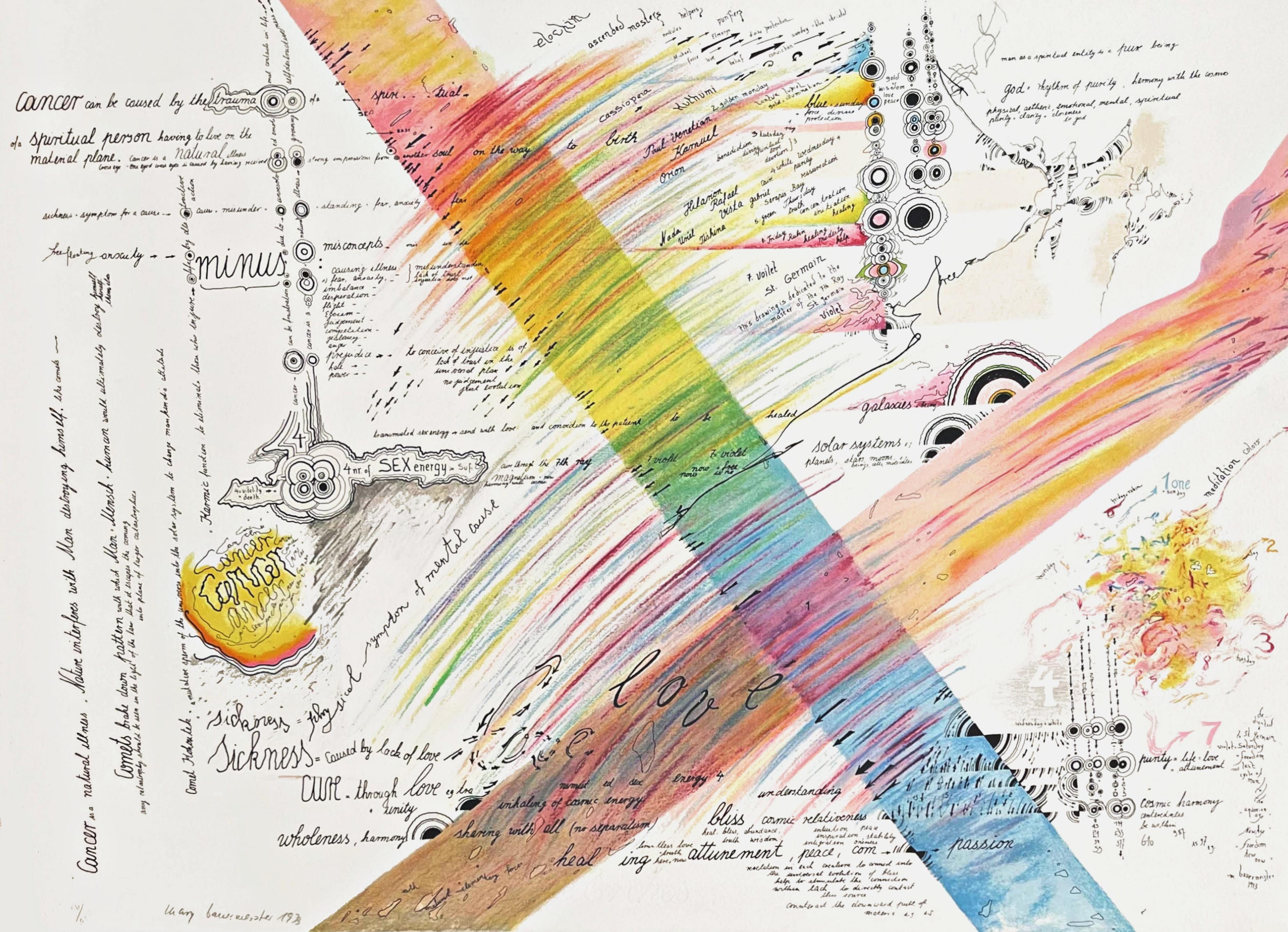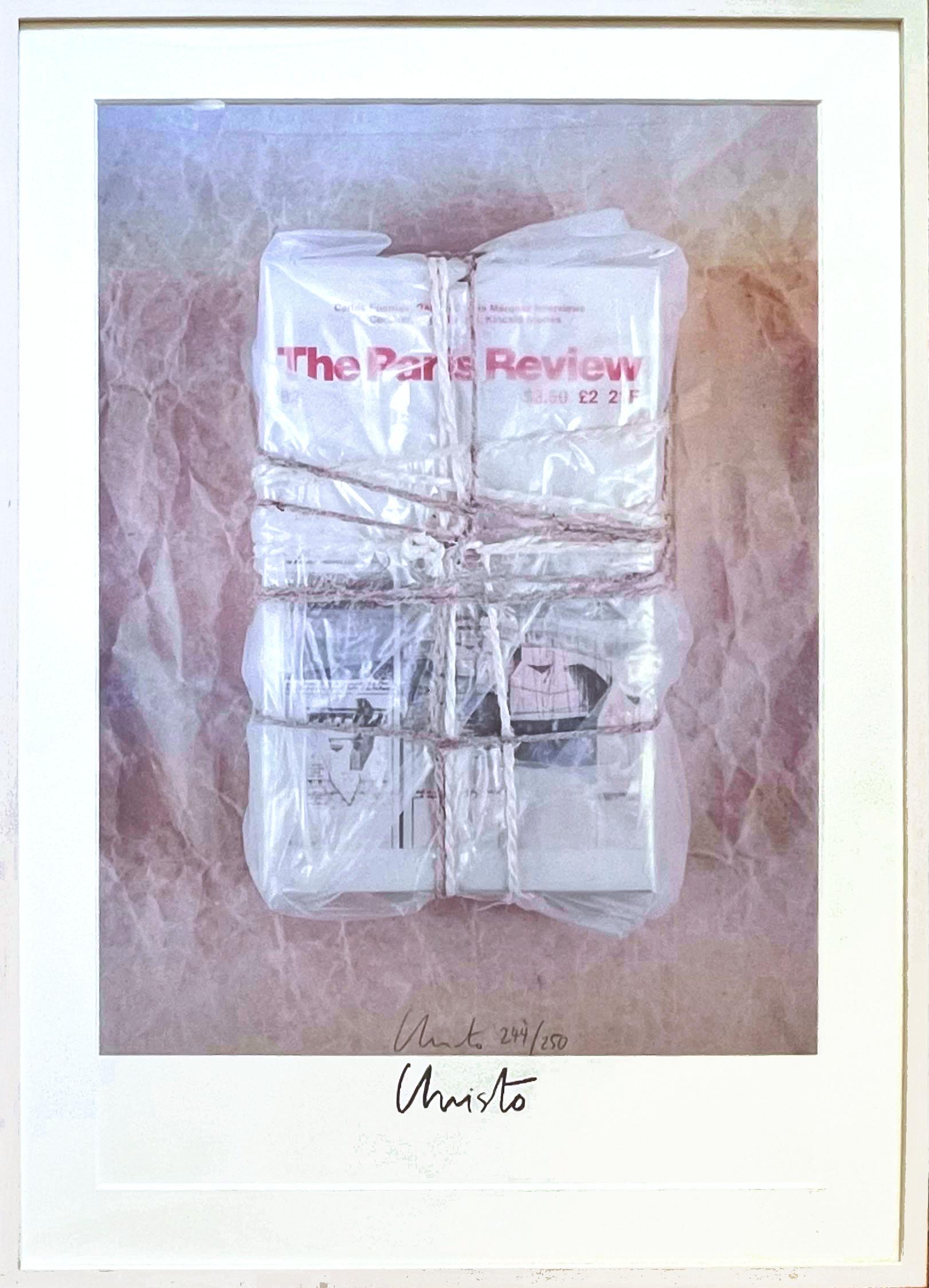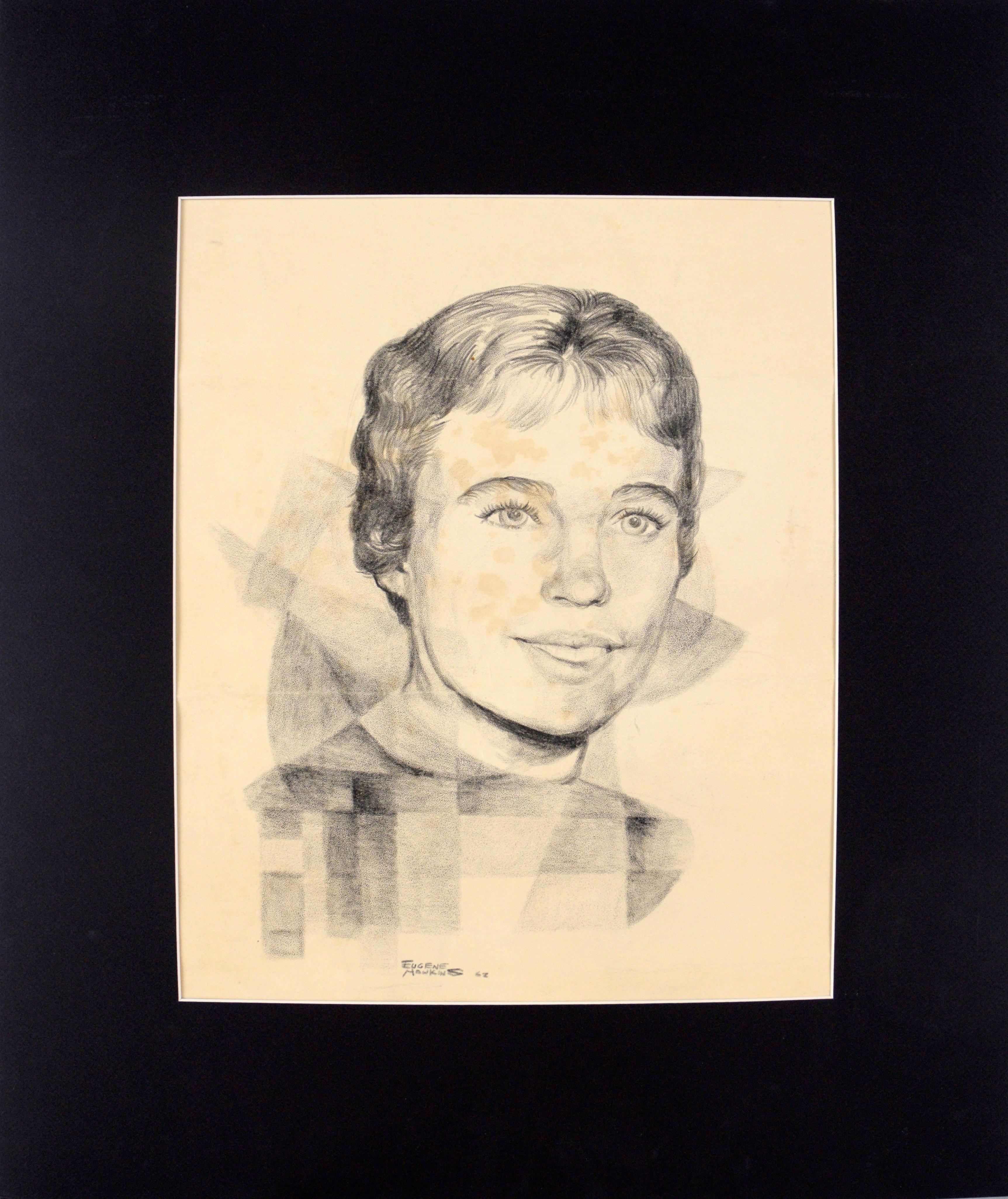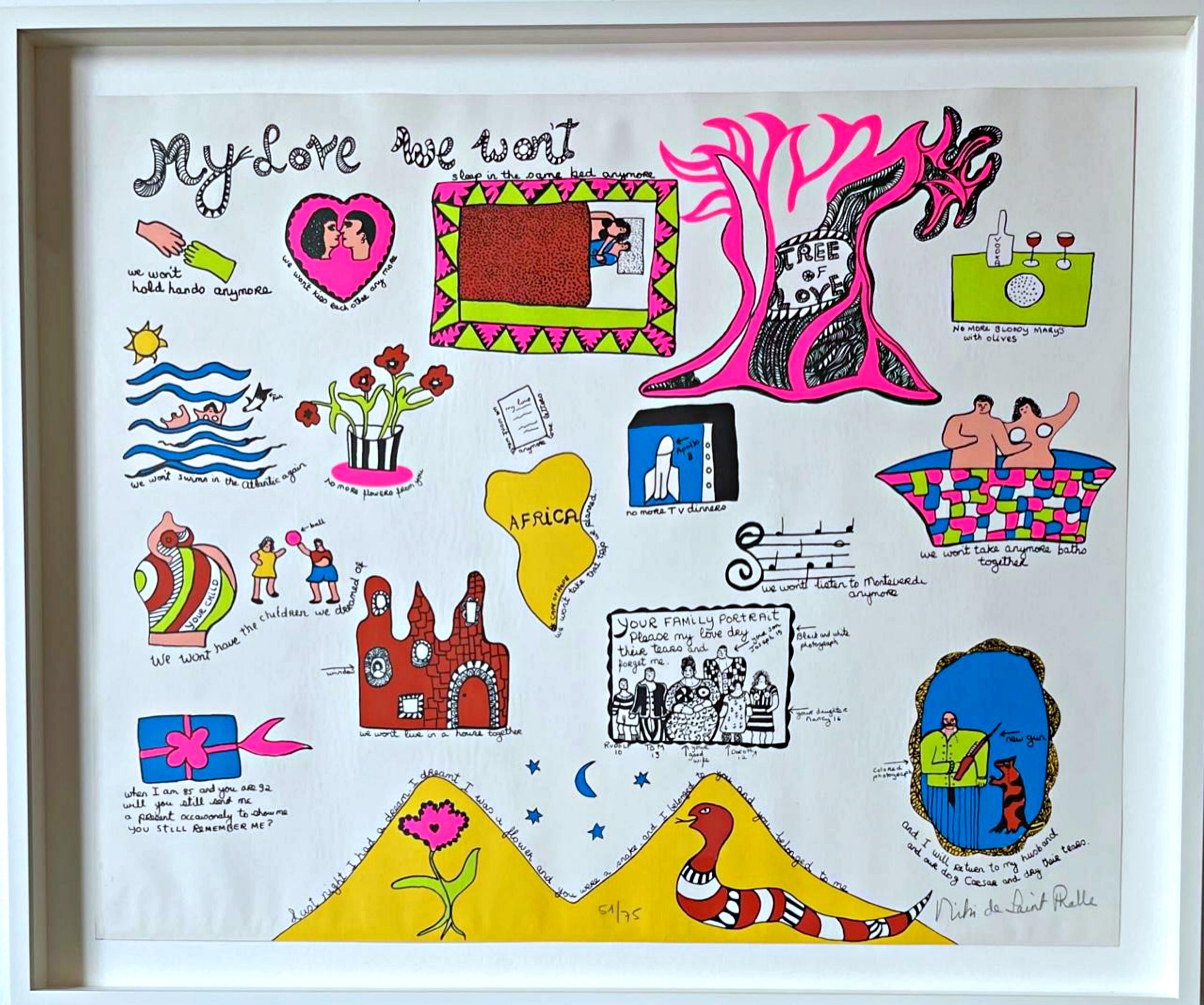Items Similar to Window on Another Dimension, signed/n lithograph by Picasso's famous mistress
Want more images or videos?
Request additional images or videos from the seller
1 of 10
Françoise GilotWindow on Another Dimension, signed/n lithograph by Picasso's famous mistress1981
1981
About the Item
Françoise Gilot
Window on Another Dimension, 1981
Lithograph on Arches mould made Johannot paper
Signed and numbered in graphite pencil; also bears artist's monogram with date, edition of 60
Frame included: floated in the original vintage frame
Measurements:
Framed
30 inches vertical by 22 inches horizontal by .75 inches depth
Artwork:
27.25 inches by 19.75 inches
Francoise Gilot was not just Picasso's muse; she was an accomplished artist in her own right, and at age 100, the New York Times dubbed her the art world's latest "It Girl".! Signed and numbered in graphite pencil; also bears artist's personal monograph with date. Held in original vintage frame under plexiglass. Charmingly, there is a sticker label on the back of the frame, from the "Picasso Gallery Custom Framing" in D.C.
This silkscreen is based upon Gilot's eponymous painting, also done in 1981
Excerpt from Alan Riding's 2023 New York Times obituary on Gilot:
" Françoise Gilot, an accomplished painter whose art was eclipsed by her long and stormy romantic relationship with a much older Pablo Picasso, and who alone among his many mistresses walked out on him, died on Tuesday at a hospital in Manhattan. She was 101...But unlike his two wives and other mistresses, Ms. Gilot rebuilt her life after she ended the relationship, in 1953, almost a decade after it had begun despite an age difference of 40 years. She continued painting and exhibiting her work and wrote books. In 1970, she married Jonas Salk, the American medical researcher who developed the first safe polio vaccine, and lived part of the time in California. Still, it was for her romance with Picasso that the public knew her best, particularly after her memoir, “Life with Picasso,” written with Carlton Lake, was published in 1964. It became an international best seller, and so infuriated Picasso that he broke off all contact with Ms. Gilot and their two children, Claude and Paloma Picasso. Ms. Gilot’s frank and often-sympathetic account of their relationship — she dedicated the book “to Pablo” — provided much of the material for the 1996 Merchant-Ivory movie, “Surviving Picasso,” in which she was played by Natascha McElhone, with Anthony Hopkins as Picasso.
If Ms. Gilot’s book sold well, so has her art. With her work in more than a dozen museums, including the Metropolitan Museum of Art and the Museum of Modern Art in New York and the Centre Pompidou in Paris, her paintings fetched increasingly higher prices well into her later years.
As recently as June 2021, her painting “Paloma à la Guitare” (1965), a blue-toned portrait of her daughter, sold for $1.3 million in an online auction by Sotheby’s. That surpassed her previous record price, $695,000, paid for “Étude bleue,” a 1953 portrait of a seated woman, at a Sotheby’s auction in 2014.. And in November 2021, her abstract 1977 canvas “Living Forest” sold for $1.3 million as part of a retrospective of her work at Christie’s in Hong Kong. Lisa Stevenson, the head of curated sales for Sotheby’s in London, told ARTnews after the 2021 auction, “It isn’t commonly known that Gilot’s commitment to art was present long before her relationship with Pablo Picasso, and she was sadly often left in his shadow.”..
Marie Françoise Gilot was born into a prosperous family on Nov. 26, 1921, in Neuilly-sur-Seine, a suburb of Paris, the only child of Emile Gilot, an agronomist and chemical manufacturer, and Madeleine Renoult-Gilot. Her 19th-century ancestors had owned a couturier house of fashion whose clientele included Eugenia, the wife of Emperor Napoleon III. Marie Françoise was drawn to art from an early age, tutored by her mother, who had studied art history, ceramics and watercolor painting. Her father, however — recalled by Ms. Gilot as an authoritarian who had forced her to write with her right hand, though she was left-handed — had other ideas. Envisioning a career in science or the law for his daughter, he persuaded her to enroll at the University of Paris, where she received her bachelor’s degree in 1938 at age 17. She went on to study at the Sorbonne and the British Institute in Paris and receive a degree in English literature from Cambridge University. As war crept closer to France in 1939, her father sent her to the city of Rennes, northwest of Paris, to enroll in law school. All the while she continued working on her paintings. Then came the German occupation of Paris, in June 1940, and she joined other students in an anti-German protest march at the Arc de Triomphe. In a clash with the French and German authorities, Ms. Gilot was arrested, briefly detained and put under watch. “From day one, we were not the kind of people who would become collaborators,” she said of her family.
She continued her law studies at the University of Paris, but after taking her second-year examinations, in June 1941, she lost interest and abandoned the field, deciding to devote herself to art. She began private lessons with a fugitive Hungarian Jewish painter, Endre Rozsda, and attended classes at the Académie Julian, which numbered Matisse, Bonnard, Léger and Duchamp among its alumni. Her father was unhappy about the decision, however, and the two clashed frequently, until Ms. Gilot moved in with her grandmother. As Ms. Gilot described it in “Life With Picasso,” her first encounter with Picasso, in May 1943, was accidental. She was dining with her closest friend, Geneviève Aliquot, and an actor, Alain Cuny, in Le Catalan, a small restaurant on the rue des Grands-Augustins, near Picasso’s Left Bank studio. Picasso was at another table accompanied by his mistress at the time, the Surrealist photographer Dora Maar.
Picasso asked Cuny to introduce him to the two young women. Learning that both were painters, he invited them to visit his studio. They did so together the following day and several more times before Geneviève returned to her home in southern France. Ms. Gilot continued to visit Picasso, seemingly fearless of his growing attraction to her. She spent much of that summer with Geneviève in Provence. But in the winter of 1944 her relationship with Picasso blossomed. She was 22; he was 62. She later recalled lying naked by his side......“In 2012, she and the Picasso biographer John Richardson curated a well-attended show, “Picasso and Françoise Gilot: Paris-Vallauris, 1943-1953,” at the Gagosian Gallery in Manhattan, displaying work that she and Picasso created during their years together.. Looking at the 30 paintings here, including naturalistic portraits of herself and her grandmother, Cubist still lifes and abstractions and pictures of herself and her children, you might think for a moment that you are looking at more Picassos,” Ken Johnson wrote in his review of the show for The Times.
Asked by a New York Times Reporter if she had ever felt competitive with Picasso or his friends — among them Chagall, Braque, Matisse and Giacometti — Ms. Gilot replied: “That never entered my mind. I started painting, after all, at 3 years old. As a child, you aren’t thinking in terms of me, me, me. You are not capable of that.”
But she acknowledged that those 20th century masters had an inevitable impact. They “helped me grow,” she said, and by their very attention instilled in her a measure of self-confidence.
“I realized,” she said, “if they are so great, then I am not so small.”
- Creator:Françoise Gilot (1921, French)
- Creation Year:1981
- Dimensions:Height: 30 in (76.2 cm)Width: 22 in (55.88 cm)Depth: 0.75 in (1.91 cm)
- Medium:
- Movement & Style:
- Period:
- Condition:Print is in fine condition with no issues; it is held in its original vintage frame 1980s under acrylic.
- Gallery Location:New York, NY
- Reference Number:1stDibs: LU1745214336102
About the Seller
5.0
Platinum Seller
These expertly vetted sellers are 1stDibs' most experienced sellers and are rated highest by our customers.
Established in 2007
1stDibs seller since 2022
289 sales on 1stDibs
Typical response time: 1 hour
- ShippingRetrieving quote...Ships From: New York, NY
- Return PolicyA return for this item may be initiated within 1 day of delivery.
More From This SellerView All
- Rainbow Signed 1970s silkscreen & lithograph by pioneering female Fluxus artistBy Mary BauermeisterLocated in New York, NYMary Bauermeister Rainbow, 1973 Lithograph and silkscreen on creamy white paper Hand signed, dated and numbered 56/250 by the artist on the front 19 x 25.5 inches Unframed This work is on the permanent collection of various institutions like: Rice University, Samuel Dorksy Museum of Art, Rutgers Zimmerli Museum and Wheaton College Massachusetts. While studying the fringe sciences the 1970s, Bauermeister created Rainbow (1973), a lithograph and silkscreen. She uses a creamy white background as the base. Two intersecting diagonal bands of color transcend across the page, and black cursive lettering dances over the surface serving as a mind map of interweaving ideas. Through the central band, Bauermeister shifts through the color spectrum; she begins with red and finishes with violet. Inspired by music, she uses strokes of color that are rhythmically smeared across the lithograph. The surface lettering, a kind of visual poetry, explores her interest in human emotion and science. The viewer can see Bauermeister’s thoughts as they flow into one another through the use of words such as bliss, love, and healing. Bauermeister also includes a repetition of words such as cancer, sickness, and cure. The word cancer emerges from a cell-like shape. A careful study of the words shows that they may seem dark in nature; however, she juxtaposes these words against the cheerful title and colors. Perhaps the rainbow symbolizes a new hope, an inspiration for an optimistic future. -Courtesy to the Samuel Dorsky Museum of Art About Mary Bauermeister: A multidisciplinary artist known for her intricate and enigmatic assemblages, Mary Bauermeister (1934-2023) continues to defy categorization with layered works in a range of media. A precursory figure of the Fluxus movement—her studio was the meeting point for a number of defining artists of the avant-garde—her work plays an integral role in the discussion of art, both European and American, that emerged from the 1960s. Her reliefs and sculptures, which have incorporated drawing, text, found objects, natural materials and fabric, reference a plethora of concepts: from natural phenomena and astronomy to mathematics and language, as well as her own “spiritual-metaphysical experiences.” Maturing amidst the currents of Minimalism and Pop Art, Bauermeister’s art has resisted labels due to the singular expression of her interests and concerns, among them the simultaneous transience and permanence of the natural world with experimentations in transparency and magnification, multiplication and variation, structure and order, chance and ephemerality, introversion and extroversion. Her three-dimensional receptacles of thoughts, ideas, and notes contain visual, conceptual, and philosophical paradoxes that challenge perceptions and that offer literal and metaphorical windows into which one can glimpse the inner workings of the artist’s mind. - Courtesy of Michael Rosenfeld...Category
1970s Modern Abstract Prints
MaterialsLithograph, Screen, Mixed Media, Pencil, Graphite
- Thou Shalt Have No Other Gods Before Me (The First Commandment)By Kenny ScharfLocated in New York, NYKenny Scharf Thou Shalt Have No Other Gods Before Me (The First Commandment), 1987 5-Color lithograph on Dieu Donne handmade paper with deckled edges 24 × 18 inches Hand signed, date...Category
1980s Pop Art Abstract Prints
MaterialsLithograph, Pencil, Graphite
- Fun Vacation (200, Engberg) (Hand signed 13/16 by Ed Ruscha AND Kenny Scharf)Located in New York, NYEd Ruscha and Kenny Scharf Fun Vacation (200, Engberg), 1990 Lithograph in five colors on white Rives BFK paper (hand signed by BOTH Ed Ruscha and Kenny Scharf) 36 × 27 inches Hand-s...Category
1990s Pop Art Abstract Prints
MaterialsPencil, Graphite, Lithograph
- Wrapped Paris Review deluxe hand signed, numbered Lt Ed for literary publicationBy ChristoLocated in New York, NYChristo Wrapped Paris Review (Deluxe hand signed edition), 1982 Lithograph and offset lithograph Hand signed and numbered 244/250 by Christo on th...Category
1980s Pop Art Abstract Prints
MaterialsLithograph, Offset, Graphite, Pencil
- My Love We Wont - coveted, whimsical 1960s silkscreen by beloved female artistBy Niki de Saint PhalleLocated in New York, NYNiki de Saint Phalle My Love We Wont, 1968 Lithograph and silkscreen on wove paper Signed and numbered 51/75 in graphite pencil on the front Frame included: elegantly floated and framed in a museum quality white wood frame with UV plexiglass From the Brooklyn Museum, which has an edition of this work in its permanent collection: "Throughout her long and prolific career Niki de Saint Phalle, a former cover model for Life magazine and French Vogue, investigated feminine archetypes and women’s societal roles. Her Nanas, bold, sexy sculptures...Category
1960s Modern Abstract Prints
MaterialsScreen, Mixed Media, Lithograph, Pencil
- A Maiakovski (For Mayakovsky) signed by Alechinsky & Christine Rochefort #10/50By Pierre AlechinskyLocated in New York, NYPierre Alechinsky A Maiakovski, 1958 (For Mayakovsky) Color lithograph and offset lithograph with text Pencil numbered 10/50 and signed by BOTH artist Pierre Alechinsky and writer C...Category
Mid-20th Century Modern Abstract Prints
MaterialsOffset, Lithograph, Pencil
You May Also Like
- Geometric Woman's Portrait - Rare Signed Graphite Drawing on Paper 1962Located in Soquel, CAGeometric Woman's Portrait - Rare Signed Graphite Drawing on Paper 1962 Beautiful, soft original drawing by Eugene Hawkins (American, b. 1933). A realistic depiction of a short-haired woman, her large lips parted into a soft smile. She's surrounded in geometric shapes offering a wonderful juxtaposition to the natural curves of her face and hair. Signed in pencil, "Eugene Hawkins '62" Presented in a new black mat. Mat size: 20"H x 16"W Paper size: 18.5"H x 14.5"W Eugene Hawkins (American, b. 1933) is a BIPOC artist known for his detailed portraiture and printmaking. He is listed in Who Was Who in American Art, 1564-1975, and his work was exhibited in the Whitney Museum of American Art. He spent the majority of his life working and exhibiting in Southern California. His work frequently touches upon socio-political subjects, making strong statements about the world. The California African American Museum features Eugene Hawkins's work in the Permanent Collection. Exhibition: 2017 Paperworks: Selections from the Permanent Collection focuses on works on paper produced from 1950-2000 and includes figurative, impressionistic, and abstract styles. The exhibition showcases the radically diverse range of works on paper created by African American and other artists over the last two centuries, and includes drawings, prints, paintings, and collages by Edward Mitchell Bannister...Category
1960s American Modern Figurative Prints
MaterialsGraphite, Paper
- Passeggiata RomanaBy Massimo Campigli, 1895-1971Located in New York, NYA very good impression of this color lithograph. Artist's proof, aside from the edition of 175. Signed, dated and inscribed "Epreuve d'artiste" in pencil. Printed by Desjobert, Paris...Category
1950s Futurist Abstract Prints
MaterialsColor Pencil, Lithograph
- Le Reve de ParisBy Marc ChagallLocated in New York, NYMarc Chagall Le Rêve de Paris (Paris Dream), 1969-70 Color lithograph on Arches wove paper 35 3/8 in x 25 1/4 in (90 cm x 64 cm) 40 1/8 in x 28 1/8 in (101.8 cm x 71.5 cm) Numbered f...Category
1960s Modern Figurative Prints
MaterialsLithograph
- Some People TogetherBy Karel AppelLocated in New York, NYSome People Together, 1974 Hand-signed and dated in pencil Color lithograph and screenprint Sheet 22 x 29 3/4 inches; 559 x 756 mm. Edition 110Category
1970s Modern Abstract Prints
MaterialsLithograph, Screen
- Some People TogetherBy Karel AppelLocated in New York, NYSome People Together, 1974 Hand-signed and dated in pencil Color lithograph and screenprint Sheet 22 x 29 3/4 inches; 559 x 756 mm. Edition 110Category
1970s Modern Abstract Prints
MaterialsLithograph, Screen
- Edward Sacks, Seated FigureLocated in New York, NYLittle is known about the artist, Edward (Ed) Sacks, although this print may have been made at the Art Students League in NYC. it is a cross between, as the title suggests, a Seated ...Category
1940s American Modern Figurative Prints
MaterialsLithograph





